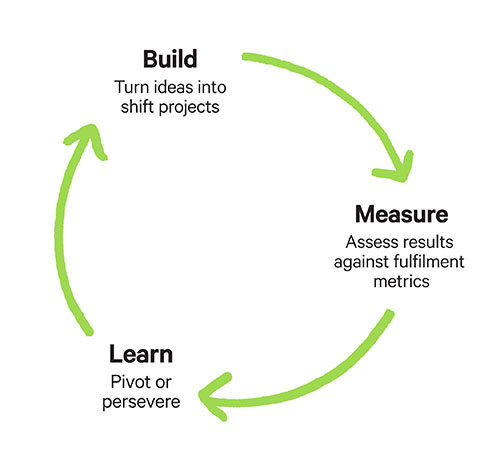
Where do you start on your career change when you're worried about finances, when you have so few free hours in the day and when it all feels so risky? Richard explains how 'going lean' can help you move forward.
What’s the one thing that’s most stopping you find a career you love?
Fear? Inertia? Analysis-paralysis? Lack of time? Lack of money?
I would argue none of these. Of course you’re feeling them. And of course they’re not helping you make your shift. But I believe there’s a deeper reason.
And it’s down to one thing: uncertainty.
You’re uncertain about what you really want to do. You’re uncertain about where to start. You’re uncertain about how to make the finances work. Or you’re uncertain about how to break into the field with little or no experience.
Uncertainty creates risk. Risk leads to fear. Fear leads to inaction. It’s fundamentally what makes career change tough.
So, how do you move forward despite this uncertainty?
Look sideways
I believe great lessons come from entrepreneurs.
The comparison isn’t new. In their book ‘The Start-Up of You’ (well worth a read, if you get a chance), Reid Hoffman and Ben Casnocha talk about the need for each of us to adopt an entrepreneurial mindset to successfully navigate the new career landscape.
But what’s particularly interesting is looking how entrepreneurs deal with exactly the same uncertainty challenges you’re facing.
This also forms the basis of how we help people at Careershifters.
We call it ‘The Lean Career Change’.
The language is adapted from the ‘Lean Startup’, a book by Eric Ries that has defined one of the strongest methodologies for the way entrepreneurs navigate the early stages (and uncertainties) of their venture.
So how does a Lean Career Change work?
Go see for yourself
Taiichi Ono, creator of Toyota’s production system, is credited for coining the phrase Genchi Genbutsu, or, ‘go see for yourself’.
If there was a problem on the factory floor, he encouraged workers to physically go and see what was happening, rather than reporting it based on theory or speculation.
This is the fundamental principle behind the Lean Career Change.
It’s called ‘validated learning’.
Validated learning works by testing out your ideas based on facts in the real world – not on research, not on planning, and not on the fears or hopes you've attached to your theories.
It's about minimising the uncertainty on your journey. But it’s also about making it a lot more fun.
There are three steps in the process, shown below.

Step 1: Build
Choose an idea and then figure out the smallest possible thing you can do to practically test it out.
In the context of career change, we call this a Shift Project.
There are three key requirements of a Shift Project:
- It should take no more time, effort or cost than is necessary
- It’s got to make it clear to you whether your idea has some viability as a future work possibility (see Step 2)
- It must be based in the real world – or in other words, involve the principle of ‘Genchi Genbutsu’
Shift Projects can be an hour long or a few months’ long, though ideally, the shorter they are, the better.
What are some examples of Shift Projects?
Here are some that our Career Change Launch Pad graduates have used in their shifts:
- Annika, a researcher, spoke to an entrepreneur pioneering more sustainability in the interior design industry to learn more about her work
- Alex, a project manager, volunteered part-time for a tech start-up to see how it would feel compared to the large corporate environment he’d come from
- Michelle, an administrator, went to a culinary exhibition to explore how she could potentially turn her love of food into paid work
- Simon, an IT consultant, started a mindfulness group in his office to test whether he could potentially grow it into a business
Notice how our Launch Pad participants’ Shift Projects were done at little or no cost – and how they could be fitted around their day jobs.
Step 2: Measure
Use three ‘fulfilment metrics’ to assess your project:
1. Resonance (Does it give me energy?)
2. Competence (Am I good at it?)
3. Sustainability (Can I make a living from it?)
The intersection of these three – what we call your fulfilment sweet spot – is ultimately where you’re aiming to get to.
But your Shift Project doesn’t need to give you evidence on all three. If it does, great; but if you can sufficiently measure one of these metrics, you’ll have enough to know what next step to take.
Step 3: Learn
Based on whether your Shift Project has been successful (or fallen short), you have a choice to make.
Do you pivot or persevere?
If you discover that your idea meets your fulfilment metrics, you can persevere, potentially running another Shift Project to help you further refine where you’re headed.
And if your idea falls short in a particular area, you’re going to need to pivot – or course-correct.
Find what doesn’t work as much as what does
As Eric Ries says, “if you cannot fail, you cannot learn.”
The same goes for career change.
It sounds paradoxical, but if you’re going to find the work that’s right for you, you also have to find the work that isn’t right for you.
That means taking ‘wrong’ turns or going down dead-ends on your journey. But the advantage of taking the lean approach is that you’re minimising your risks at the same time.
How Mark is using the lean career change to make his shift
Our coaching client Mark O’Loughlin is a great example of these principles in action.
Mark has been stuck for a number of years in his role as marketing manager for a publishing company.
He doesn’t have the finances to just quit his job. And besides that, he’s not clear on what else he really wants to do.
Instead of being stuck in analysis-paralysis, he’s started to run a number of Shift Projects.
Mark has always loved working with people. One of his ideas was that life coaching could be an interesting career direction.
So, his first Shift Project was attending a coach-training weekend.
Because the weekend was free (though clearly being used as a sales mechanism for paid-for courses), it provided Mark with an ideal way to get a taste of coaching without him having to incur costs or take time off work.
Even before the weekend had finished, it was clear to Mark this was not for him. “I just couldn’t picture myself doing it. It didn’t motivate me enough.”
Or, in order words, it fell short on his resonance metric.
So, what did he do?
He pivoted.
Maintaining the theme of his love of working with people, he started instead to look at charity fundraising.
His next Shift Project happened in the pub, where he met a friend who worked as a charity fundraiser for a drink.
His conversation with her touched on not only what her role involved day-to-day, but also how she got into the field (she’d also made a shift from sales and marketing).
Notice what Mark did here.
He didn’t start by Googling fundraising, nor by researching fundraising roles on job sites. Instead, he applied the ‘go see for yourself’ principle and went out into the real world to meet his friend.
He also crafted a Shift Project that only took a few hours, so he could do it after work.
Sufficiently inspired by the meeting with his friend (his Shift Project scored strongly on the resonance metric and her story gave him enough initial evidence that he could use his skills and make a living in the role), he persevered.
His next Shift Project built on his previous one.
He asked his friend if he could shadow her in her role a few hours a week. She agreed.
That has since developed from an hour or two here and there to a full day’s volunteering every week, enabling Mark to build experience in the area and positioning him well, as and when the time is right, to make a bigger jump into this area.
Mark’s story is one that’s still in progress, but through using lean principles, he’s minimising his risk and maximising clarity about what is really right for him.
Get started
So how can you apply the lean career change principles to your shift?
If you’re searching for your ‘what’:
- Start a Shift Project. If you’re in a day job, find something you can do in your free time. Make it small. Make it fun. Don’t know what project to start on? Choose something that interests you. The trick is to choose something, even if you’re not convinced it’s the right thing. Just begin.
- Go through the Build - Measure - Learn feedback loop. Keep your Shift Projects time- and cost-effective. Expect your pivots to be large initially. Repeat the feedback loop as fast as you can.
- Narrow down to one idea that you can take forward – or if you want to have a portfolio career, two or three ideas.
If you’re searching for your ‘how’:
- Create a Shift Project around whatever it is you want to do. Keep it small. Keep it simple.
- Go through the Build - Measure - Learn feedback loop. Use your Shift Projects to build your experience in your field, make new connections and get clarity about how you’re actually going to make your shift. Appreciate that you may need to take intermediary steps – and test these too.
- Once you’ve validated your route, start down it
In both cases, if you want to move faster, speed up your build-measure-learn feedback loop.
Finally, don’t do it alone.
Put a support team around you: it’s going to be one of your greatest accelerators. Our Career Change Launch Pad does exactly this. Or work with a coach. Or build your own team. What’s important is you have people to support you and keep you accountable on your journey.
How can you use the lean career change methodology in your shift? What Shift Project can you start on? Leave a comment below.




